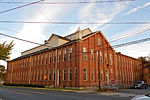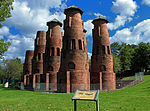Catasauqua High School
Catasauqua High School is a public high school serving grades 9 through 12 in Northampton, Pennsylvania in the Lehigh Valley region of eastern Pennsylvania. As of 2021-22, the school had 498 students, according to National Center for Education Statistics data. Catasauqua High School is the only high school in the Catasauqua Area School District. The school district also includes Catasauqua Middle School, which serves grades 5 through 8, and Francis H. Sheckler Elementary School, which serves kindergarten through grade 4. Although Catasauqua High School is part of the Catasauqua Area School District and serves the residents of Catasauqua, Pennsylvania, the school building is physically located in the city and county of Northampton. The previous high school building, situated in Catasauqua proper, is now the middle school building. The previous middle school building, which was, in fact, the original high school building, is currently home to the Innovative Arts Academy. The school's mascot is the Rough Rider, and its school colors are brown and white, with gold sometimes used as an accentuating third color.
Excerpt from the Wikipedia article Catasauqua High School (License: CC BY-SA 3.0, Authors).Catasauqua High School
Saw Grass Drive, Allen Township
Geographical coordinates (GPS) Address Nearby Places Show on map
Geographical coordinates (GPS)
| Latitude | Longitude |
|---|---|
| N 40.6786 ° | E -75.4674 ° |
Address
Catasauqua High School
Saw Grass Drive
18032 Allen Township
Pennsylvania, United States
Open on Google Maps







